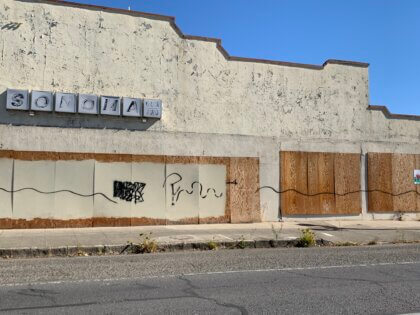 Larry Barnett lives in Sonoma where he was elected to three terms on the City Council and served twice as Mayor. A thirty-three-year resident, he currently serves as Chair of Sonoma's Planning Commission. He has been married for 48 years, has two daughters and three grandchildren.
Larry Barnett lives in Sonoma where he was elected to three terms on the City Council and served twice as Mayor. A thirty-three-year resident, he currently serves as Chair of Sonoma's Planning Commission. He has been married for 48 years, has two daughters and three grandchildren.
City life 101: Nuisances and nuisance abatement

We’ve all seen properties with decrepit vehicles, abandoned equipment, trash, overgrown weeds and buildings in severe disrepair. Sometimes it’s a result of financial hardship, other times willful neglect by a property owner. A good example of owner neglect in Sonoma is the former Truck and Auto business property at the corner of Broadway and MacArthur streets. Everyone agrees a decrepit and dilapidated lot like that would benefit from new development, but until that happens the condition of the property is up to its owner in Texas. Or is it?
Nuisances: Public and Attractive
When it comes to nuisances, Sonoma’s Municipal Code defines two types: public and attractive. A public nuisance includes property that’s covered in waste or refuse, with stagnant standing water, buildings in such deterioration or disrepair that “causes visual blight, or reduces the aesthetic appearance of the neighborhood, or is offensive to the senses, or is detrimental to nearby properties, or constitutes a hazard to persons or property.”
The code goes on to further define such public nuisance conditions subject to abatement, and includes, in part: “Buildings which are abandoned, partially destroyed for a period of at least six months, or left in an unreasonable state of partial construction.” Also: Unpainted buildings and those having dry rot, warping, or termite infestation; Any building on which the condition of existing paint has become so deteriorated as to permit substantial decay, checking, cracking, peeling.”
Another formal nuisance: “Building exteriors, walls, fences, gates, hedges, structures, driveways, sidewalks, walkways, or alleys which for at least 72 consecutive hours are maintained in such condition as to be defective, unsightly, or in such a condition of deterioration or disrepair that the same constitutes visual blight or reduces the aesthetic appearance of the neighborhood or is offensive to the senses or is detrimental to nearby properties.”
The city’s abatement of public nuisances includes demanding that the nuisance conditions be corrected, and if such demands are ignored, provides that the city may proceed to correct the nuisance conditions at the expense of the property owner and potentially the placement of a tax lien on the property..
The other type of nuisance is the attractive nuisance type, which is defined as dangerous to children and others, “including, but not limited to, abandoned, broken, or neglected household appliances, equipment and machinery; lack of malfunctioning or unmaintained safety devices, safety equipment, fences or barriers, as required by the city’s building code, for pools, spas, ponds, and excavations.”
The list of attractive nuisances is long, and in part covers, “Dead, decayed, diseased, or hazardous trees, weeds, and overgrown or uncultivated vegetation”, “Any wall, sign, fence, gate, hedge, or structure maintained in such condition of deterioration or disrepair as to constitute a hazard to persons or property, or constitute visual blight,” and “The non maintenance of any yard which causes excessive dust or airborne pollutants”. Most of us can identify properties displaying some of these conditions.
Abatement by the City
The right of abatement is covered by code section 14.30.030 – Abatement by civil action. “A civil action may be brought in the name of the people of the state to abate a public nuisance as defined in this section, by the city attorney, or the district attorney or county counsel of the county, and each of said officers shall have concurrent right to bring such action for a public nuisance within this city. The city attorney shall bring such action when directed to do so by the city council.”
A step-by-step process is outlined in the Municipal Code detailing the process of notices and public hearings, and actions that may be taken to abate the nuisance. Ultimately, if the property owner refuses to correct the nuisance and the city undertakes to correct the nuisance itself, all costs incurred by the city in the abatement process must be paid by the property owner. If that payment is not made, the city may resort to placing a lien on the property.
Although the abatement process is rarely used, it has been employed successfully in the past. Like any civil action, a complaint must be made, and any citizen can make a complaint about either public or attractive nuisances. Complaints should be made in writing to the City Manager and City Council, and delivered by hand or via mail.
In summary, the city does have solutions at its disposal: “Whenever there is imminent or immediate danger to a significant portion of the public, by the existence or continuance of any nuisance endangering the public health, welfare or safety, arising from any act, condition or use or occupation of property, or otherwise amounting to a nuisance per se, it is the duty of the city council or the appropriate officials of the city to abate such nuisance.”
By Larry Barnett
One thought on “City life 101: Nuisances and nuisance abatement”
Comments are closed.




So, why not get started now? Instead of having a couple of city council candidates using this thing as a talking point to create a total misconception about why a useless market rate development, with a couple of over priced, token cubicles labeled affordable should have been built, let’s have the city do something useful. Have the city clean up the thing, create community gardens and bill the owner in Texas to make it happen.